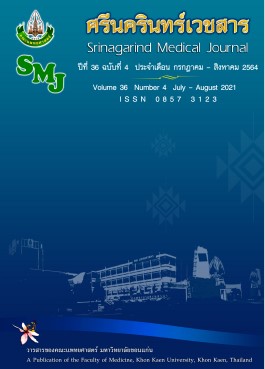Knowledge, Attitudes and Practices of Health Workers Handling Cytotoxic Drugs: A Study in a University Hospital in Northeastern Thailand
Keywords:
knowledge; attitude; handling cytotoxic drugs; health workersAbstract
Background and objective: Adequate knowledge and proper attitudes alongside correct practice can reduce risk of occupational exposure performing activities related to cytotoxic drugs. This study aimed to assess level of knowledge, attitude and practice of health workers handling cytotoxic drugs at a university hospital in north-eastern Thailand.
Methods: A descriptive study was conducted during May – June 2020. Validated questionnaires were distributed to 253 health workers. The data were analyzed into median, interquartile range, frequency, percentage and Chi-Square. p≤0.05 was considered statistically significant.
Results: The response rate was 86.6% (219/253) and mostly were female (89.5%). Most were nursing health workers (78.1%) and almost half (47.9%) performed chemotherapy administration. The results showed that 55.7% of participants had satisfactory level of knowledge regarding antineoplastic agents. Answering on the correct personal protective equipment while handling these hazardous drugs was the category of questions with the lowest score (44.6%). More than two-third (67.1%) of participants had a good attitude toward handling cytotoxic drugs, nevertheless only 39.3% had a skilful level and 64.1% reported wearing gloves inappropriately.
Conclusions: Most respondents had a good attitude (67.4%) but, slightly more than half had sufficient knowledge (55.7%) and the overall practice was fair to poor. Incorrect personal protective equipment is the most problematic issue. Hence, educational program and training on safety procedure in all chemotherapy related activities continually are recommended.
References
2. McDiarmid M, Egan T. Acute occupational exposure to antineoplastic agents. Occup Med (Lond): official publication of the Industrial Medical Association 1988; 30(12): 984-987.
3. Valanis BG, Vollmer WM, Labuhn KT, Glass AG. Association of antineoplastic drug handling with acute adverse effects in pharmacy personnel. Am J Hosp Pharm 1993; 50(3): 455-462.
4. Dranitsaris G, Johnston M, Poirier S, Schueller T, Milliken D, Green E, et al. Are health care providers who work with cancer drugs at an increased risk for toxic events? A systematic review and meta-analysis of the literature. J Oncol Pharm Pract : official publication of the International Society of Oncology Pharmacy Practitioners 2005; 11(2): 69-78.
5. Ratner PA, Spinelli JJ, Beking K, Lorenzi M, Chow Y, Teschke K, et al. Cancer incidence and adverse pregnancy outcome in registered nurses potentially exposed to antineoplastic drugs. BMC Nurs 2010; 9: 15.
6. Valanis B, Vollmer WM, Steele P. Occupational exposure to antineoplastic agents: self-reported miscarriages and stillbirths among nurses and pharmacists. J Occup Environ Med 1999; 41(8): 632-638.
7. Fransman W, Kager H, Meijster T, Heederik D, Kromhout H, Portengen L, et al. Leukemia from dermal exposure to cyclophosphamide among nurses in The Netherlands: quantitative assessment of the risk. Ann Occup Hyg 2014; 58(3): 271-282.
8. Ben-Ami S, Shaham J, Rabin S, Melzer A, Ribak J. The influence of nurses' knowledge, attitudes, and health beliefs on their safe behavior with cytotoxic drugs in Israel. Cancer Nurs 2001; 24(3): 192-200.
9. Kyprianou M, Kapsou M, Raftopoulos V, Soteriades ES. Knowledge, attitudes and beliefs of Cypriot nurses on the handling of antineoplastic agents. Eur J Oncol Nurs 2010; 14(4): 278-282.
10. Turk M, Davas A, Ciceklioglu M, Sacaklioglu F, Mercan T. Knowledge, attitude and safe behaviour of nurses handling cytotoxic anticancer drugs in Ege University Hospital. Asian Pac J Cancer Prev 2004; 5(2): 164-168.
11. Polovich M, Martin S. Nurses' use of hazardous drug-handling precautions and awareness of national safety guidelines. Oncol Nurs Forum 2011; 38(6): 718-726.
12. Occupational Safety and Health Administration. Controlling Occupational Exposure to Hazardous Drugs [Internet] 2016. [cited 2020 January 23]. Available from: https://www.osha.gov/hazardous-drugs/controlling-occex.
13. American Society of Hospital Pharmacists. Drug Distribution and Control: Preparation and Handling: Handling Hazardous Drugs [Internet] 2006. [cited 2020 January 23]. Available from: https://www.ashp.org/-/media/assets/policy-guidelines/docs/guidelines/handling-hazardous-drugs.ashx.
14. Oncology Nursing Society. Toolkit for Safe Handling of Hazardous Drugs for Nurses in Oncology [Internet] 2018. [cited 2020 January 24]. Available from: https://www.ons.org/sites/default/files/2018-06/ONS_Safe_Handling_Toolkit_0.pdf.
15. Mahdy N, Rahman A, Seddek G. Nurses' Performance Regarding Chemotherapy Administration in the Clinic Nglaa. Egypt J Health Care 2018; 9: 129-140.
16. Hengpraprom S, Kulwanvijit N, Jiamjarasrangsi W. Investigation of safety precautions of healthcare workers in handling antineoplastic drugs at King Chulalongkorn Memorial Hospital. CHULA MED J 2006; 50: 319-330.




